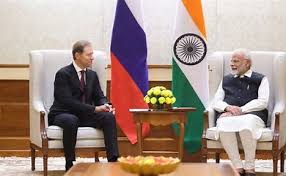 India’s GDP growth rate for 2013-14 is now forecast at around 5 per cent and the impression is that recession has bottomed out. But is this growth sufficient to create jobs for 66 per cent of the young population which is the highest in the world? The slowdown can be attributed to both domestic and external factors. Policy unpredictability and slow implementation were in turn due to the tangled political situation at the Centre which contributed to industrial slowdown. External factors like slack import demand from the US and the EU were behind the low export growth. Inflation and its control led to high interest rates that stifled investment. The latest ILO data, however, show that 17 million jobs were created in the past few years (2009-2012) but 85 per cent of the jobs offered no benefits or social security. Job creation will thus remain the prime economic challenge in the forthcoming general election for any political party aspiring for power.
India’s GDP growth rate for 2013-14 is now forecast at around 5 per cent and the impression is that recession has bottomed out. But is this growth sufficient to create jobs for 66 per cent of the young population which is the highest in the world? The slowdown can be attributed to both domestic and external factors. Policy unpredictability and slow implementation were in turn due to the tangled political situation at the Centre which contributed to industrial slowdown. External factors like slack import demand from the US and the EU were behind the low export growth. Inflation and its control led to high interest rates that stifled investment. The latest ILO data, however, show that 17 million jobs were created in the past few years (2009-2012) but 85 per cent of the jobs offered no benefits or social security. Job creation will thus remain the prime economic challenge in the forthcoming general election for any political party aspiring for power.
Even with a marginal rise in the GDP growth rate, which could be due to higher agricultural growth this year, the job situation may not improve much. It would require at least 6 per cent growth rate to create enough jobs in the economy. Also the need of the hour is for the Indian industry to adopt more labour-intensive techniques and not go in for more capital-intensive production methods. Because of the small number of jobs created in the formal sector, job seekers have to find jobs in the informal sector where there is little job security.
One of the ways to create more secure jobs is to give an impetus to the service sector. With so many wonderful things to show, India ought to attract a huge number of tourists whose demand would be able to support a number of people in the service sector. Even villages can be great tourist spots if there are good places to stay and things to do. Experiencing life in an Indian village should be an exciting adventure for anyone coming from Western countries.
Instead of developing village and making them additional centres for tourism, there has been a strong migratory flow to cities and towns in search of work. Most villages have neglected rest houses and few places to eat. In some regions, there is a short supply of labour to work during the harvest time. Many blame the MNREGA for this shortage but the real reason is that people migrate to towns and cities in search of regular jobs and higher wages. The cities, on the other hand, absorb migrants but are short of housing space and the new migrants end up in slums. Around 50 per cent of the people in Mumbai live in slums.
As a result, cities have huge inequalities and recently IMF chief Christine Lagarde said in London that the networth of Indian billionaires has soared 12-fold in 15 years. But wages of the poor have not increased much by comparison. Most Indian cities have become very congested and the poor are huddled together on the outskirts as in Delhi or live in the dirtiest areas, often near drains, in the inner city.
There already is a big problem of solid waste disposal and availability of safe drinking water.
I ndia is now extending ‘visa on arrival’ to tourists from 180 countries to encourage tourism. But budget tourists, who aim at staying in small hotels/guest houses and not five-star hotels, face problems in finding clean and safe accommodation. Seeing open garbage all over cities is a big turn-off. Sanitation problems will plague Indian cities in the future most. Even if the slums are hidden away from the main city centre, lack of sanitation will have an impact on the whole city. Garbage disposal is a huge problem and much of it is burnt which adds to pollution. On an average cities generate 31.3 million tonnes of garbage a year and 86,000 tonnes of municipal solid waste per day. Water treatment plants are also not adequate. As a result, raw sewage is released into rivers and the sea.
ndia is now extending ‘visa on arrival’ to tourists from 180 countries to encourage tourism. But budget tourists, who aim at staying in small hotels/guest houses and not five-star hotels, face problems in finding clean and safe accommodation. Seeing open garbage all over cities is a big turn-off. Sanitation problems will plague Indian cities in the future most. Even if the slums are hidden away from the main city centre, lack of sanitation will have an impact on the whole city. Garbage disposal is a huge problem and much of it is burnt which adds to pollution. On an average cities generate 31.3 million tonnes of garbage a year and 86,000 tonnes of municipal solid waste per day. Water treatment plants are also not adequate. As a result, raw sewage is released into rivers and the sea.
In most western cities, there is no open garbage to be seen and sanitation is a top priority for the local municipal government. Tap water is safe and the air is clean. Pollution in big cities in India is also being caused by vehicular traffic. Lack of an efficient public transport system in major metro cities has led to the rapid growth of vehicular traffic. In no other city is traffic as thick as in Delhi where the density of cars is among the highest. This is because there is no network of commuter trains connecting suburbs with the capital and the underground metro connectivity is not adequate and hence each middle class family has a number of cars. The per capita income is also the highest in Delhi. High-spending tourists may not experience seeing slums but are bound to see open garbage from the airport to the hotel surrounded by stray dogs and beggars/scavengers. They will also experience air pollution but may escape water pollution by drinking bottled water. But on the whole the strain could be too much to make them want to come back.
Women tourists will not be attracted to Delhi, given the reputation of being the rape capital. Not only Delhi, rapes are common in other cities also. In all there are many deterrents to the targeted increase in tourism in India today. Thus tourism and the accompanying hotel, hospitality and aviation industries are likely to suffer.
Thus in the service sector, only the Information and Communication Technology (ICT) can generate more jobs in future but educational and technical requirements and the ability to speak English will restrict the numbers. Hence, there will be problems in the service sector’s ability to create jobs.
For a higher GDP growth the main generator of employment and income is the manufacturing sector which should grow faster in future. In the past due to low investment, manufacturing growth has been below par. It is again infrastructural constraints that are standing in the way of a higher manufacturing growth rate that plunged to 0.2 per cent in 2013. Lack of good roads (though there is much progress in some states), poor port facilities involving long waits, along with water and power shortages are big problems for industry in India. Also, land acquisition and clearances can cause huge delays. Hence, the only way out is to create industrial parks and special manufacturing zones/hubs for industrial development that would generate jobs for the semi-skilled youth.
(The writer is a Senior Fellow at Observer Research Foundation, Delhi)
–Courtesy: ORF; The Tribune
Author Profile
- India Writes Network (www.indiawrites.org) is an emerging think tank and a media-publishing company focused on international affairs & the India Story. Centre for Global India Insights is the research arm of India Writes Network. To subscribe to India and the World, write to editor@indiawrites.org. A venture of TGII Media Private Limited, a leading media, publishing and consultancy company, IWN has carved a niche for balanced and exhaustive reporting and analysis of international affairs. Eminent personalities, politicians, diplomats, authors, strategy gurus and news-makers have contributed to India Writes Network, as also “India and the World,” a magazine focused on global affairs.
Latest entries
 India and the WorldNovember 26, 2025G20@20: Africa’s Moment – The Once and Future World Order
India and the WorldNovember 26, 2025G20@20: Africa’s Moment – The Once and Future World Order DiplomacyOctober 4, 2025UNGA Resolution 2758 Must Not Be Distorted, One-China Principle Brooks No Challenge
DiplomacyOctober 4, 2025UNGA Resolution 2758 Must Not Be Distorted, One-China Principle Brooks No Challenge India and the WorldJuly 26, 2025MPs, diplomats laud Operation Sindoor, call for national unity to combat Pakistan-sponsored terror
India and the WorldJuly 26, 2025MPs, diplomats laud Operation Sindoor, call for national unity to combat Pakistan-sponsored terror India and the WorldJuly 25, 2025When Fire Ends, Diplomacy Begins
India and the WorldJuly 25, 2025When Fire Ends, Diplomacy Begins







